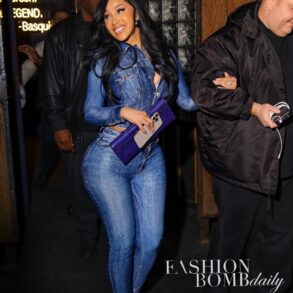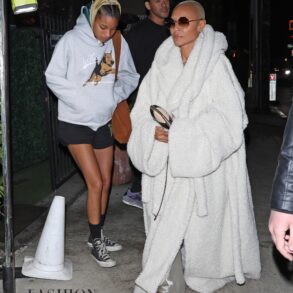
This article is an on-site version of our Swamp Notes newsletter. Sign up here to get the newsletter sent straight to your inbox every Monday and Friday
I remember when I moved from New York City to London in the late 1990s, I was struck by how sloppy everyone looked compared to my peers in the Big Apple. New York was about power dressing — sleek Armani or Calvin Klein suits and a kind of careful, quiet luxury that was epitomised by the late Carolyn Bessette-Kennedy, who was in fact a publicist for Calvin Klein before marrying John F Kennedy Jr.
Nobody in Manhattan went out without a super straight blow dry and a fresh, neutral coloured mani/pedi. Sure, it looked professional. But it was also kind of boring. Clothes in New York, then and now, tend to be about fitting in rather than standing out. They are the armour that protects you in a high stakes careerist world. Things have loosened up since the pandemic, but now, rather than everyone wearing the same sheath dress, everyone is wearing the same oversized cashmere sweater, performance silk trousers and leather sneakers (in neutral colours of course).
London, on the other hand, was all about a kind of messy creativity. When I arrived in 1998, Alexander McQueen was ascendant, making scull scarves and armadillo shoes, and Isabella Blow (she of the amazing hats) was the person whose picture you always saw in the fashion pages. Women on the High Street had mussed hair and chipped nail polish, but also interesting and crazy combinations of patterns and proportions and style genres all in one outfit. Standing out, rather than fitting in, seemed important. And being too serious about it all wasn’t cool.
I am thinking about sartorial codes these days, because Washington is going through a bit of a sea change on this score. DC has always been a formal city, the kind of place that can make New York fashion seem edgy. Traditional dark coloured suits and ties for men, and “toast coloured stockings” and jewel toned dresses for women have until recently been basic attire. In DC, people don’t want to shock — they want to schmooze. I used to feel edgy just wearing opaque black tights in the Beltway instead of regular pantyhose.
There’s still plenty of that conservative sartorial vibe around, but as politics are changing, so is DC style. Consider Pennsylvania senator John Fetterman, a Democrat who likes to sport sweatshirts and shorts around the Capitol. This is a guy who has a Harvard degree, mind you, but he was once mayor of a steel town, and the vibe he clearly wants to project is: “I’m a working man, not part of the Beltway elite.”
A more casual dress code in DC has actually been endorsed by majority leader Chuck Schumer. Rather than barring anyone not in a suit from entering the congressional chamber, “Senators are able to choose what they wear on the Senate floor. I will continue to wear a suit.” Plenty of younger politicians will too, but probably hipper versions of the same, as the New York Times’ recently reported: young progressives in particular are embracing more diverse style as a way of communicating inclusivity and policy creativity.
I remembering thinking something very important had changed in DC when I went to do an interview at the White House with Heather Boushey, a member of the president’s Council of Economic Advisers, about two years ago and found that she was wearing a cool pair of combat boots. Perhaps that is what’s needed to do political battle these days in Washington. Perhaps it’s representative of an administration that’s making some major pro-labour shifts in the economy. Or maybe I’m over-reading all this.
Alec, my question to you, as our foreign affairs editor, is this: what does London fashion, and particularly London political fashion, tell us about the UK? And do you think, as I do, that cities tell us something about themselves through fashion?
Recommended reading
-
I’ve been on a magazine reading tear recently, and some of my favourite pieces include this recent Atlantic cover story, “Jenisha From Kentucky,” which is one of the most honest and powerful feature stories I’ve read in some time. Jenisha Watts, a senior editor for the Atlantic, writes about her childhood growing up in a crack house. It will sadden, but also surprise you, in important ways.
-
Another A+ for feature writing in the Atlantic goes to Ross Andersen for his piece on AI: “Does Sam Altman Know What He’s Creating?” Answer: no. We should all be worried.
-
Isaac Chotiner’s lovely New Yorker profile of my favourite conservative opinion writer, Ross Douthat, says as much about our cultural moment as it does about the subject.
-
Former White House competition adviser Tim Wu is absolutely correct that the Google antitrust trial is really about the future of AI.
-
I was intrigued by this piece on @GstaadGuy in the Weekend FT. He’s made a pseudonym for himself by mocking Eurotrash culture online. Fun story, but what’s really interesting is to see the evolution of fiction in the digital age.
Alec Russell responds
Rana, I love your idea that as the FT’s foreign affairs editor I should consider fashion part of my beat! In truth, only once in several decades of writing about the world has fashion played a role in my geopolitical analyses, and that was a rather special case when covering Nelson Mandela in the 1990s.
As South Africa’s first democratically elected president, he deployed fashion brilliantly to help his political ends. He became known for his sparkling thigh-length brightly coloured shirts. They signalled how the country had changed from the dour besuited days of apartheid. Mandela always had a reputation as a snappy dresser even as an activist in the 1950s. But he understood too that the trick is to know when to dress down — and when to dress up. He wore an immaculately tailored dark suit when meeting Queen Elizabeth II during a 1996 state visit to Britain.
So what of London’s political fashion? Sadly it’s a much duller affair than Mandela’s South Africa and not dissimilar to Washington’s. If anything I think you, Rana, are a little generous to DC’s traditional style. When I lived there in the early noughties, standard male political apparatchik garb was a shapeless blazer and chinos and brown or grey shoes.
Britain’s prime minister Rishi Sunak favours slim-cut dark suits, as does his fellow financier turned world leader, President Emmanuel Macron of France. I suppose it is meant to reflect a crisp business-like approach. It is certainly quite a contrast to the shambolic style of his predecessor Boris Johnson, whose cultivated dishevelled look proved quite a hit with voters on his way up.
Right now though, the nation seems desperate for the merest hint of competence from its leaders. My hunch is that it is certainly happy to do without snazzy or striking outfits in Number 10 Downing Street if that is part of the price for having an organised government. If the polls are right, in a year or a little more, Keir Starmer, the Labour party leader, will be in Number 10. He too is a man of sober suits. If he does win power he will of course surprise us; new leaders always do. But I really don’t think he will surprise us via what he wears. These are drab penny-pinching times in Britain and the prevailing dress code will reflect that.
Your feedback
And now a word from our Swampians . . .
In response to “The slow, lingering death of the UN?”:
“Broadening the UN Security Council (UNSC) would only risk further paralysis as we saw during the cold war, and more recently over the Hermit Kingdom’s belligerence. Besides, incorporating more members in the UNSC would simply turn it into another ‘group of X’ countries, mirroring the G20 in size and scope. For a guide, look no further than the Asean grouping, which requires unanimity for its communiques and has been derided by critics as a ‘talk shop’ with nothing to show for it. Calling Asean a ‘talk shop’ may be a tad harsh, but at least it brings heads of state together for dialogues. I suspect a similar fate lies in wait for the UN . . . ” — Nicholas Chia
Your feedback
We’d love to hear from you. You can email the team on swampnotes@ft.com, contact Alec on Alec.Russell@ft.com and Rana on rana.foroohar@ft.com, and follow them on X at @RanaForoohar and @AlecuRussell. We may feature an excerpt of your response in the next newsletter






This site truly has all of the information and facts I needed concerning this subject and didn’t know who to ask.